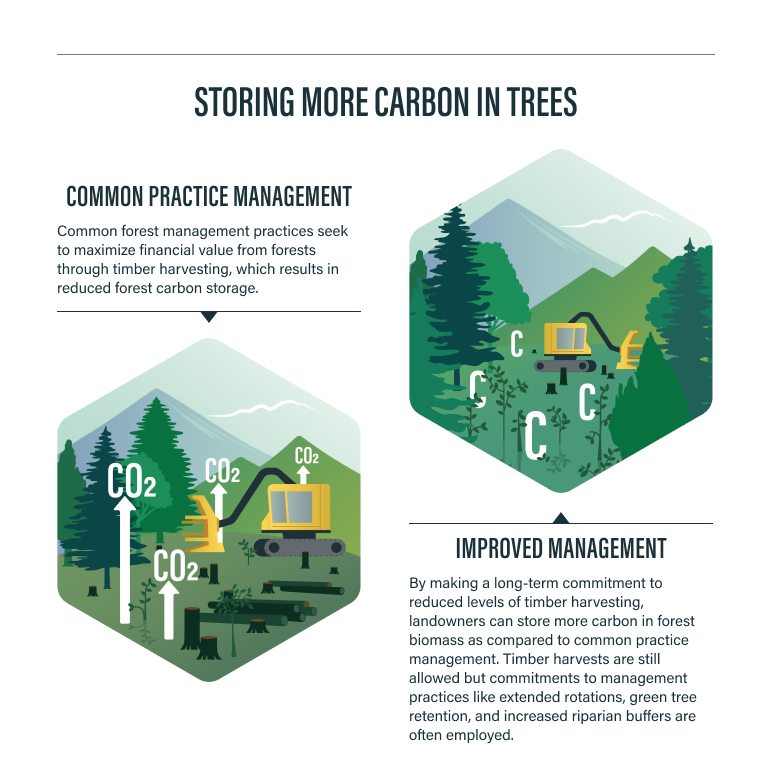Improved Forest Management
The Climate Trust works with forest owners to design carbon projects that improve their management flexibility and climate resiliency.
After centuries of land conversion and frequent natural disturbances, protecting and enhancing forests across the nation is one of the most cost-effective natural climate solutions to reduce global carbon emissions and help us meet the world’s 2030 mitigation goals. By adjusting how we manage forests, we can increase carbon storage and build climate resilience for the ecosystems that are critical to providing us with abundant clean water, wildlife habitat, and biodiversity.
The Climate Trust works with private and public forest owners, including land trusts and Tribal nations. We understand the many stakeholders involved in managing forest lands and manage every step of the process for our partners. By ensuring that both small and large landowners can access carbon markets, we’re making it easier for land stewards to take climate positive action and rely less on frequent timber harvesting as the sole revenue source to manage their forests.
Project Development Process


The Climate Trust works directly with landowners to determine their eligibility, conduct a forest inventory, model forest carbon growth, develop a project, conduct ongoing monitoring, reporting and third-party verification, and market and sell resulting carbon credits.
Why work with us?
Across the country, our projects demonstrate how carbon sequestration and sustainable timber harvesting go hand in hand to support rural economies. We’ve worked on projects ranging from 3,000 to 113,000 acres from Maine to Florida to the Oregon coast. From our first site visit with landowners, we work closely with them to help them meet their forest management goals. We finance, develop, and manage the entire carbon project. This includes paying for third-party costs at no markup, issuing offsets, and marketing and selling offsets for the best price to generate a new revenue stream for landowners.
The Climate Trust has a proven track record of putting our partners and their land first. We work alongside both public and private landowners, managers, and land trusts around the country to fund, develop, and manage improved forest management projects that work for their land. As a nonprofit and one of the oldest carbon entities in the nation, we have a breadth of experience including public and private forest management, operations, forestry consulting, sustainable forestry certifications, and forest carbon investments.

what are improved forest management projects?
Improved forest management is a term used for projects where the activities associated with forest management increases carbon storage over a business-as-usual level. These projects generate additional revenue streams for forest managers and owners, allowing for more flexible forest management and silviculture as they meet their annual financial targets. Though the rate and reliance on timber harvesting will decrease, forest owners are still able to engage in sustainable timber harvesting. Improved forest management projects benefit rural economies, wildlife, water quality, and generally protect open space.
common terms
- Common Offset: the storage or avoided emission of one metric ton of carbon dioxide (the atmospheric equivalent) after applying transparent, science-based carbon accounting and passing third-party verification.
- Co-benefits: positive impacts on the ecosystems, biodiversity, wildlife, and community surrounding a carbon project.
- Additionality: the reduction or removal of carbon emissions resulting from a carbon project compared to a baseline. Projects must demonstrate that the forest is being managed to store additional carbon above legal requirements and property encumbrances, above common practices for similar forests in the region, and beyond what timber-focused financial analysis indicates.
- Third-party Verification: the verification of a project’s eligibility, measurements, and modeling through an ANSI-accredited verification body or auditor.
- Green Tree Retention: retaining more trees individually or in groups during timber harvests.
- Extending Rotation: allowing trees to live longer and grow larger before harvest increases overall forest carbon stocks.
- Increased Riparian Zones: Enlarging riparian management zones or increasing basal area limits stores more carbon in riparian stands.